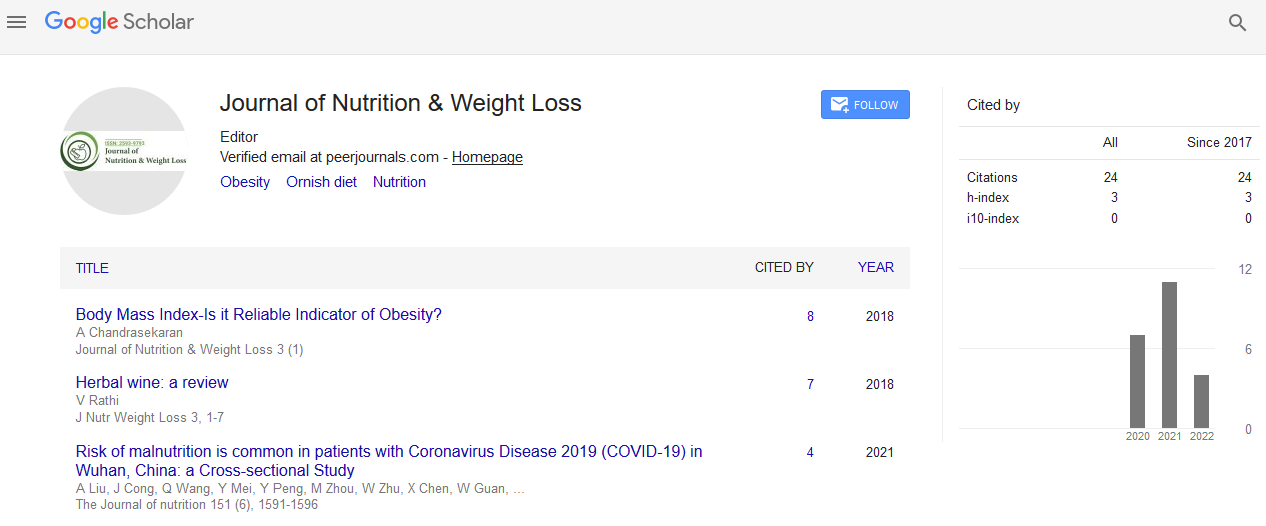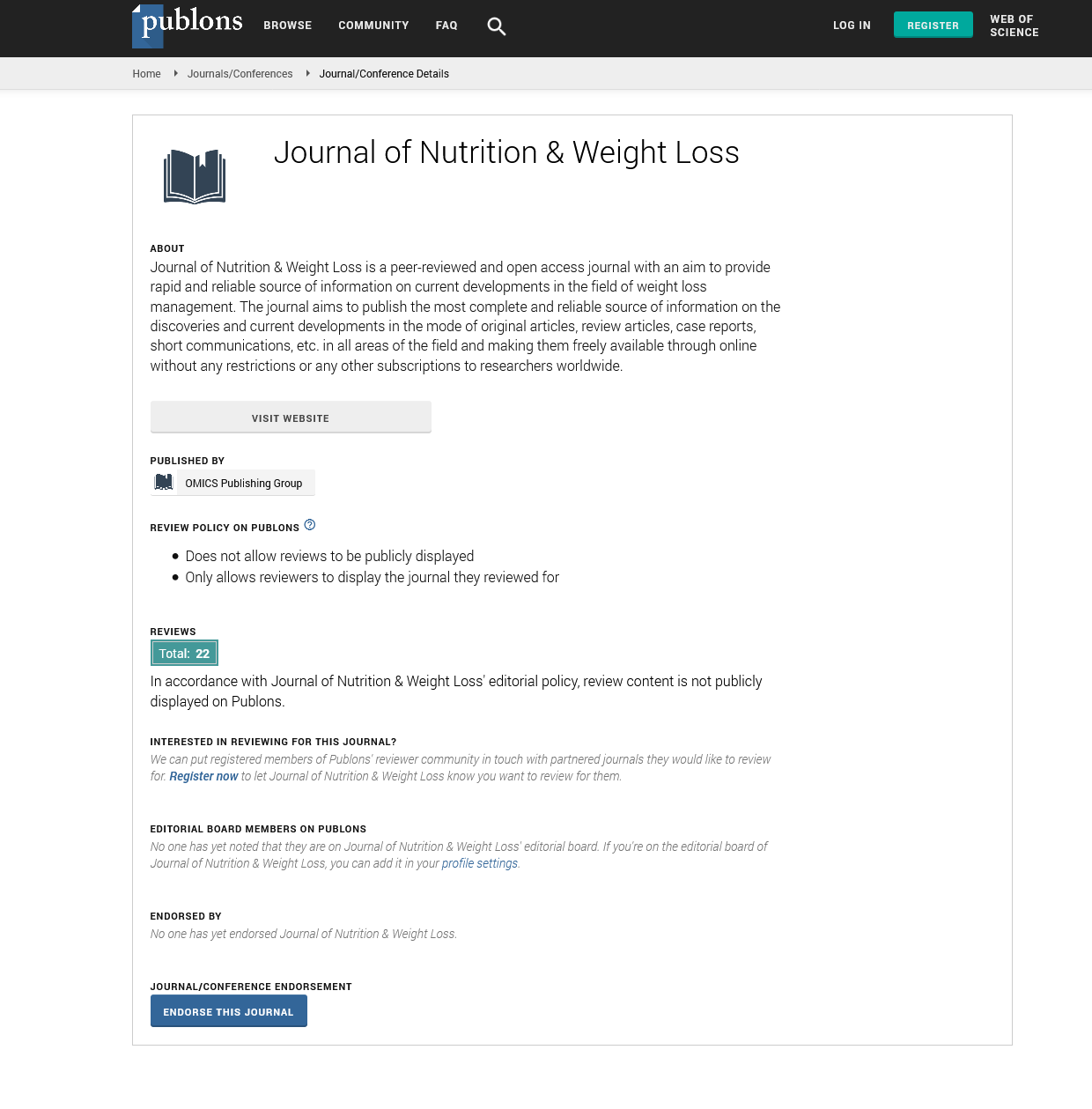Indexed In
- RefSeek
- Hamdard University
- EBSCO A-Z
- Publons
- Euro Pub
- Google Scholar
Useful Links
Share This Page
Journal Flyer

Open Access Journals
- Agri and Aquaculture
- Biochemistry
- Bioinformatics & Systems Biology
- Business & Management
- Chemistry
- Clinical Sciences
- Engineering
- Food & Nutrition
- General Science
- Genetics & Molecular Biology
- Immunology & Microbiology
- Medical Sciences
- Neuroscience & Psychology
- Nursing & Health Care
- Pharmaceutical Sciences
Commentary - (2022) Volume 7, Issue 1
Nutrient Deficiency Diseases
David Perez*Received: 04-Jan-2022, Manuscript No. JNWL-22-15536; Editor assigned: 07-Jan-2022, Pre QC No. JNWL-22-15536 (PQ); Reviewed: 18-Jan-2022, QC No. JNWL-22-15536; Revised: 24-Jan-2022, Manuscript No. JNWL-22-15536(R); Published: 31-Jan-2022
Description
Malnutrition features a huge variety of conditions, which include undernutrition in general, undernutrition main to weight problems, consuming disorders, and illnesses for which vitamins performs a role. Globally, undernutrition and weight problems are primary public fitness problems. The remedy of malnutrition is frequently complex with the aid of using elements inclusive of war, famine, and infectious illnesses. Obesity stays hard to deal with as soon as present, despite the fact that advances with inside the knowledge of the nutritional body structure mentioned on this bankruptcy are main to new pharmacological and surgical interventions.
Nutritional interventions in the treatment of disease may involve the use of a therapeutic diet, the use of dietary supplements or the provision of nutritional support, enteral or parenteral.
Nutritional disease, any nutrient-related disease and conditions that cause disease in humans. These can include deficiencies or excesses in the diet, obesity and eating disorders, as well as chronic diseases such as cardiovascular disease, hypertension, cancer and diabetes.
Malnutrition is a condition in which there is not enough food to meet energy needs; its main features include weight loss, stunting reduction, and body fat and muscle loss.
Malnutrition, a physical condition caused by an incorrect or inadequate diet (i.e. a diet that does not provide normal amounts of all nutrients) or the body’s inability to absorption or metabolism of nutrients. Symptoms of malnutrition are often obvious, with those affected often experiencing weight loss, fatigue, and muscle weakness. Impaired immune function, dry skin, tooth decay, osteoporosis, dizziness, and mental confusion (eg, inability to concentrate) may also occur. However, in many cases, simple dietary modifications can easily reverse the harmful effects of malnutrition. Supplements, such as vitamins and minerals, can be used to aid recovery.
Kwashiorkor, a Ghanaian word meaning illness first contracted by a child upon arrival, is commonly seen when a child is weaned from protein-rich breast milk to a carbohydrate food source with an inadequate amount of protein. Children with this disease manifest as a distended abdomen due to edema (water retention), thinness, slow growth, susceptibility to infectious diseases, which can lead to fatal diarrhoea. Nutritional status should be restored as quickly and safely as possible; Children who are starving can gain weight quickly within a week or two.
The World Health Organization notes: Cardiovascular disease, proper nutrition can reduce a person’s chances of developing this disease. An unbalanced diet or a diet high in fat and cholesterol can significantly contribute to a person’s risk of the disease. People can avoid heart problems by avoiding foods that contain saturated fat or trans fats and cholesterol, choosing instead foods rich in polyunsaturated fats, such as those containing omega-3 fatty acids. Choosing to eat more fruits and vegetables, whole grains, and low- sodium foods is also a good idea.
Some types of cancer can be prevented with proper nutrition. Making sure you have plenty of fruits and vegetables in your diet will help reduce your risk of developing cancer. Focus on foods like soy, which have been shown to reduce the risk of breast cancer. Osteoporosis causes bones to become porous, which is one of the leading causes of broken and brittle bones. Fortunately, eating well can improve bone health and reduce the risk of fractures. Seniors should make sure they get the daily recommended amount of vitamin D and calcium, two nutrients that help build strong bones. The National Institutes of Health recommends getting at least 500 mg of calcium per day and 600 international units of vitamin D per day.
Obesity is directly related to diet and is associated with an underlying factor in many other health conditions, such as cardiovascular disease and diabetes. This ratio can mainly be attributed to high- calorie meals and sedentary lifestyle. Obesity is a major concern in older adults, who tend to become less active over time.
Citation: Perez D (2022) Nutrient Deficiency Diseases. J Nutr Weight Loss. 7:127.
Copyright: © 2022 Perez D. This is an open-access article distributed under the terms of the Creative Commons Attribution License, which permits unrestricted use, distribution, and reproduction in any medium, provided the original author and source are credited.


